Test Your Understanding
Chapter 3: Analysis Techniques
Test Score
| Question | Score |
| 3.1 | 0 / 20 |
| 3.2 | 0 / 20 |
| 3.3 | 0 / 20 |
| 3.4 | 0 / 20 |
| 3.5 | 0 / 20 |
| 3.6 | 0 / 20 |
| 3.7 | 0 / 20 |
| 3.8 | 0 / 20 |
| 3.9 | 0 / 20 |
| 3.10 | 0 / 20 |
| 3.11 | 0 / 20 |
| 3.12 | 0 / 20 |
| 3.13 | 0 / 20 |
| 3.14 | 0 / 20 |
| 3.15 | 0 / 20 |
| 3.16 | 0 / 20 |
| 3.17 | 0 / 20 |
| 3.18 | 0 / 20 |
| 3.19 | 0 / 20 |
| 3.20 | 0 / 20 |
| 3.21 | 0 / 20 |
| 3.22 | 0 / 20 |
| 3.23 | 0 / 20 |
| 3.24 | 0 / 20 |
| 3.25 | 0 / 20 |
| 3.26 | 0 / 20 |
| 3.27 | 0 / 20 |
| 3.28 | 0 / 20 |
| 3.29 | 0 / 20 |
| 3.30 | 0 / 20 |
| 3.31 | 0 / 20 |
| 3.32 | 0 / 20 |
| 3.33 | 0 / 20 |
| 3.34 | 0 / 20 |
| 3.35 | 0 / 20 |
| 3.36 | 0 / 20 |
| 3.37 | 0 / 20 |
| Total | 0 / 100 |
Test 3.1
Circuit Elements
Linear circuit elements include Resistors and diodes:
Test 3.2
Circuit Elements
Linear circuit elements include Resistors, capacitors, and inductors:
Test 3.3
Circuit Elements
An active element requires an external power source to operate.
Test 3.4
Circuit Elements
Linear circuit elements include Diodes and transistors:
Test 3.5
Circuit Elements
A resistor is a passive element, but a capacitor is an active element.
Test 3.6
Circuit Elements
A diode is a nonlinear passive element.
Test 3.7
Circuit Elements
A BJT is an active element.
Test 3.8
Thevenin Equivalent
Find the Thevenin equivalent resistance at terminals (a,b).
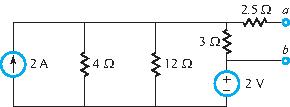
Test 3.9
KCL
For the circuit shown, application of KCL at node V
0 gives
(choose one answer):
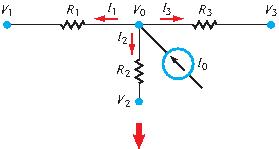
Test 3.10
Supernode
Choose one answer:
Test 3.11
Supermesh
Choose one answer:
Test 3.12
Source Superposition
Choose one answer:
Test 3.13
Maximum Current
Choose one answer:
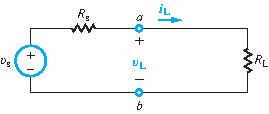
Test 3.14
Maximum Voltage
Choose one answer:

Test 3.15
Maximum Power
Choose one answer:

Test 3.16
OR Gate
Which of the following input/output tables is true for an OR gate?
Test 3.17
Digital Inverter
When a BJT is used in a digital inverter circuit, it means that:
Test 3.18
Node Voltage
Determine V
x.

Test 3.19
Nodal Analysis
Determine V
R.

Test 3.20
Dependent Source
Determine V
x.

Test 3.21
Dependent Source
Determine power dissipated in the 2 Ω resistor.

Test 3.22
Voltage
Determine V
x.
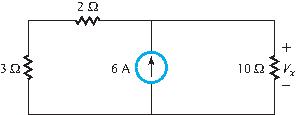
Test 3.23
Supermesh
Determine I
x.
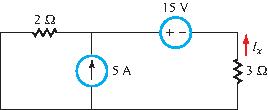
Test 3.24
Thevenin Equivalent
Find the Thevenin equivalent voltage at terminals (a,b).

Test 3.25
Thevenin Equivalent
Find the Thevenin equivalent resistance at terminals (a,b).

Test 3.26
Thevenin Equivalent
Find the Thevenin equivalent voltage at terminals (a,b).
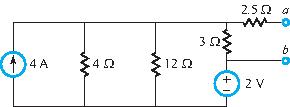
Test 3.27
Thevenin Equivalent
Find the Thevenin equivalent resistance at terminals (a,b).

Test 3.28
Norton Equivalent
Find the Norton equivalent current at terminals (a,b).
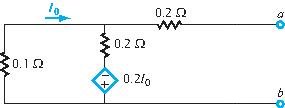
Test 3.29
Norton Equivalent
Find the Norton equivalent resistance at terminals (a,b).

Test 3.30
Maximum Power
What value of R
L will extract maximum power from the circuit?

Test 3.31
Node Voltage
Determine V
x.

Test 3.32
Nodal Analysis
Determine I
x.

Test 3.33
Dependent Source
Determine V
x.

Test 3.34
Supermesh
Determine I
x.
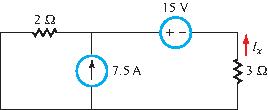
Test 3.35
Thevenin Equivalent
Find the Thevenin equivalent voltage at terminals (a,b).

Test 3.36
Thevenin Equivalent
Find the Thevenin equivalent resistance at terminals (a,b).

Test 3.37
Thevenin Equivalent
Find the Thevenin equivalent voltage at terminals (a,b).

























